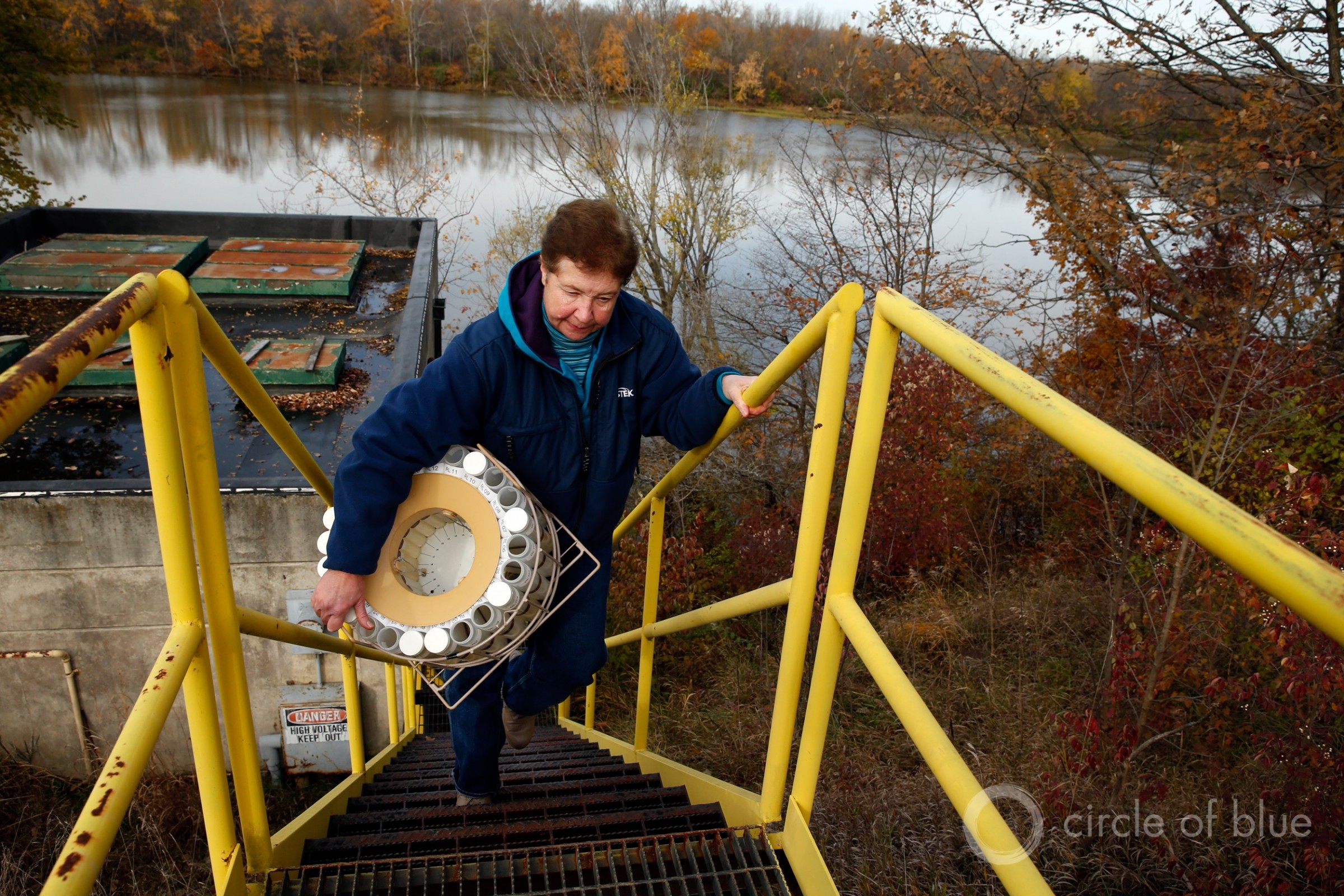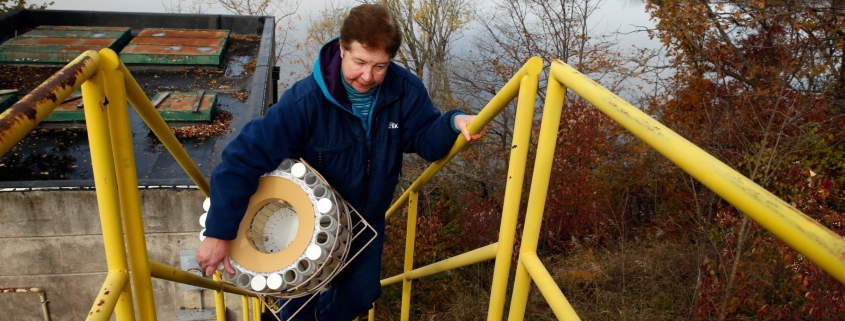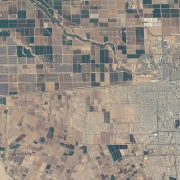With Heavy Spring Rains, Lake Erie Algal Bloom Forecast Gets Worse and Worse
A bigger bloom, however, does not necessarily mean a more toxic bloom, researchers caution.

Barb Merryfield, a research assistant at Heidelberg University’s National Center for Water Quality Research, leaves a U.S. Geological Survey gauge site on the Maumee River at Waterville, Ohio, on November 4, 2013. Data from Heidelberg’s water monitoring program suggest that high levels of phosphorus in rivers in early spring correlate closely with large summer algal blooms in Lake Erie. They also suggest that “pulses” of nutrients released during a large spring storm, encourage more algal growth than relatively consistent releases of phosphorus from point source dischargers like municipal wastewater plants. Photo © Scott Strazzante/Circle of Blue
By Brett Walton, Circle of Blue
On a bad algae day in the summer it can take a boat a half hour or more to motor through the thick green mats that accumulate in Lake Erie’s western basin, observes Laura Johnson, director of the National Center for Water Quality Research at Heidelberg University, in Ohio.
The algae are a drag on the fishing industry and a threat to public drinking water supplies. Unfortunately for boaters and lakeshore cities more such bad days are likely in the next few months.
The latest Lake Erie forecast from Heidelberg and the National Oceanic and Atmospheric Administration projects a large buildup of harmful cyanobacteria, or blue-green algae, this summer. It should be one of the largest blooms in the beleaguered lake since 2002. Every week since mid-May the bloom’s projected severity has narrowed toward the upper end of the range of outcomes.
Lake Erie’s degradation is emblematic of an era. In the last decade, harmful algal blooms have plagued waterways across the country, from Florida’s estuaries and inland lakes to the Ohio River and the foothills of the Oregon Cascades. The blooms have resulted in beach closures and drinking water advisories. Environmental Working Group mapped reported U.S. algae outbreaks since 2010. The incidents spread from coast to coast.
The Lake Erie bloom won’t peak until August or September, so in these early days researchers look at rain and river flows as predictors of its size. A wet spring with bursts of rain triggers explosive algal growth, Johnson said. The projected severity of this year’s bloom keeps increasing because each recent rain storm turned out wetter than expected.
Several risk factors explain why Erie’s western basin is a hot spot for harmful algal blooms. The shallowest part of the shallowest Great Lake, the western basin warms more quickly than the deeper, colder lakes to the north. Algae prefer the heat.
The basin is also downstream of an area of highly concentrated agriculture. Phosphorous, a nutrient used in fertilizers, is the vitamin that fuels Erie’s algal growth. When more is deposited in the lake via the Maumee and Sandusky rivers, the likelihood of a large bloom increases.
Upstream of the Waterville monitoring station, where Heidelberg researchers gauge the Maumee’s phosphorus content before it enters the lake, more than 75 percent of the land is dedicated to row-crop agriculture. The soybean fields are a primary source of phosphorus runoff into the river.
Size, Not Toxicity
Large and colorful, a bloom’s emerald swirls are a striking sight, especially when photographed by satellite. Yet the images, though eye-catching, are imprecise. So Heidelberg and NOAA developed a system for ranking the size of the blooms. The severity index “gives the satellite image a number,” Johnson told Circle of Blue.
What the index measures is the mass of algae that forms in the lake. It incorporates both density and surface area.
What the index does not measure is toxicity. Though the cyanobacteria that comprise the bloom are able to produce neurotoxins, they won’t necessarily release them. The 2015 bloom broke the charts, rating a 10.5 on the 10-point scale, but it didn’t result in a health scare. “It was huge, it was everywhere,” Johnson recalled. “But it was not very toxic.”
This year’s bloom is forecasted to be 7 or higher.
The news-making 2014 bloom, by contrast, rated a 6 on the scale — but its effect was more pronounced. Toxins released by the bloom infiltrated Toledo’s water treatment plant, which led city officials to issue a do-not-drink advisory that lasted for two days.
Mindful of that frantic episode, Toledo voters in February endorsed giving Lake Erie legal rights. That change to the city charter is now being fought in court by farm interests.
Forecasting toxicity is much harder than gauging the scale of the bloom, Johnson said. Toxicity forecasts, helpful for boaters, swimmers, and water utilities, are a topic of intense research.
Because of the uncertainty about toxicity, Toledo officials keep close watch on their water supply. A $500 million upgrade to the Collins Park Water Treatment Plant that began in 2012 is helping them do so. The improvements include additional treatment capacity and more monitoring devices to track toxins in the lake.
The final algae forecast will be published on July 11. After that, researchers will shift their focus: from the nutrient inputs that feed the cyanobacteria to the location of the bloom itself. Wind and warm temperatures cause the green mass to drift and curl, both on the surface and below water, Johnson said.
Wind could push the bloom close to Toledo’s drinking water intakes, which extend three miles into the lake. City officials will be watching as well, ready to ward off a threat and, if necessary, sound the alarm to residents, again.
Brett writes about agriculture, energy, infrastructure, and the politics and economics of water in the United States. He also writes the Federal Water Tap, Circle of Blue’s weekly digest of U.S. government water news. He is the winner of two Society of Environmental Journalists reporting awards, one of the top honors in American environmental journalism: first place for explanatory reporting for a series on septic system pollution in the United States(2016) and third place for beat reporting in a small market (2014). He received the Sierra Club’s Distinguished Service Award in 2018. Brett lives in Seattle, where he hikes the mountains and bakes pies. Contact Brett Walton













Leave a Reply
Want to join the discussion?Feel free to contribute!